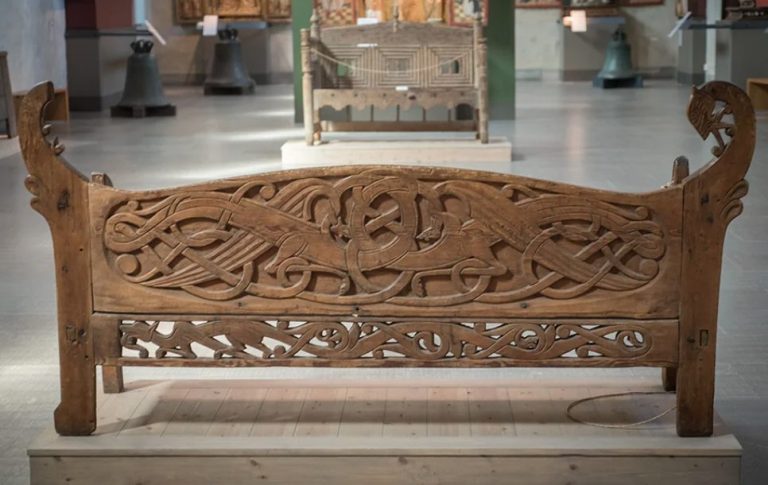In contemplation of the oldest timber furniture in the world, the curious aspect is that it’s not made from the oldest wood.
Ancient Swamp Kauri, native to New Zealand’s north island, are prehistoric trees, sometimes entire forests, that succumbed to natural events like earthquake and cyclone and remained buried in peat bog for at least 50 000 years. Timber from the younger logs (up to around 6000 years old) isn’t dissimilar to wood from a standing tree. But the 45,000-year-old timber has to be treated differently or it will break down and split. Part of its magic is its massive size. Many had already been growing for a thousand years, resulting in mammoth pieces of wood at least 12 metres in diameter and 62 metres long. It is also the oldest workable timber with its finite quantity renders it the liquid gold of lumber. Kauri still grows in parts of New Zealand as a protected species.
The combined appeal and with each piece varying greatly, makes Kauri a natural fit for woodworkers looking for something different. From a craftsman’s perspective, since it is not petrified wood, it can be finished with normal techniques. A two piece table, made from the same piece of wood and measuring 12 metres long, 13 centimetres thick and 152 centimetres wide has a price tag of $US100 000.
It has a powerful beauty; with an active grain that with it’s honeyed tones creates an impressive shimmering iridescence. Harvested from below ground, brown-black trenches score the fields of Northland as diggers reach into their resting places, pulling the logs from their holes like a molar from a mouth. Some of these trees last stretched for the sun before humans built cities, domesticated animals or developed writing and yet such is the preservative power of an anaerobic peat bog they emerge with still-green leaves stuck to their bark, as if fresh from the forest floor.
If you’re thinking about spreading the word about the virtues of this human-friendly material you’d be sadly misinformed and far to eager to fill endless lockdown hours with half-baked ideas and undercooked biscuits. This world’s most valuable and exquisite timber is also matchless as a resource for global climate science. (See what I did there?) In 2010, global interest in swamp kauri soared. Wealthy businessmen in a booming China wanted the world’s most ancient wood to enrich their boardrooms. Americans and Europeans wanted it too. In the export explosion and ruined wetlands in the rush for these buried treasures, those ancient swamps have become the battleground of modern ideology.
Swamp Kauri is the oldest wood, and it plays no part in the oldest piece of timber furniture.
That honour belongs to an amazing wooden mausoleum piece of furniture in Ankara, Turkey at the cemetery of Midas. It is created from spruce, yew, and juniper, and uses a wood piling technique that is more than 2 700 years old. Because it was in the tomb of someone so powerful, it has remained reasonably undisturbed throughout its history.
Westminster Abbey boasts Britain’s oldest and only Anglo-Saxon door and it’s more than 950 years old. Dating back to the 1050s under the reign of Edward the Confessor, it is made from a single English oak that stood two metres tall and 1.2 metres wide. Although robust Tasmanian oak entertainment units don’t demand the same criterion, who’s to say revelations and dedications don’t occur during a binge-watch marathon, for in each of us can be found our own god.
A 400-year-old bed, used by 15 generations of Berkeley family has not lost its strength or elegance and is considered one of the oldest pieces of furniture in the world. It has been located in Berkeley Castle Estate, Gloucestershire, England since 1608. That’s more than 150 000 nights of use, assuming continuous occupation of the estate. If that bed could talk Netflix would make a series that would only be good for three seasons.
If you wanted to walk through the oldest timber door to see the oldest timber furniture, it’d be fitting to have it all in the oldest timber house, since you certainly couldn’t have it in the oldest timber structure in the world because it’s a temple. Horyuji was built in 607AD from Japanese cypress. The Fairbanks House, in Dedham, Massachusetts is where the bed would be moved, the doors refitted and King Midas’ mausoleum piece moved. This historic house was built in 1641 and was passed down through eight generations of the Fairbanks family until the early 20th century. You wood have to assume it’s had a splintered history since then >boom<>tish!<
Recent Posts
- Enhance Your Space with the Perfect Entertainment Unit Style
- Revamp Your Living Space with Style: Coffee Table Transformation
- Bookcase vs Bookshelf: A Sydney Linguist Explains the Differences
- Craftsmanship at Its Finest: Unveiling Habitat Furniture’s Masterpieces
- Protect Your Timber/Wooden Furniture From Termites
Archives
- June 2024
- May 2024
- April 2024
- July 2023
- February 2022
- December 2021
- October 2021
- July 2021
- May 2021
- March 2021
- January 2021
- December 2020
- October 2020
- December 2018
- November 2018
- September 2018
- August 2018
- July 2018
- April 2018
- March 2018
- November 2017
- October 2017
- June 2017
- May 2017
- April 2017
- March 2017
